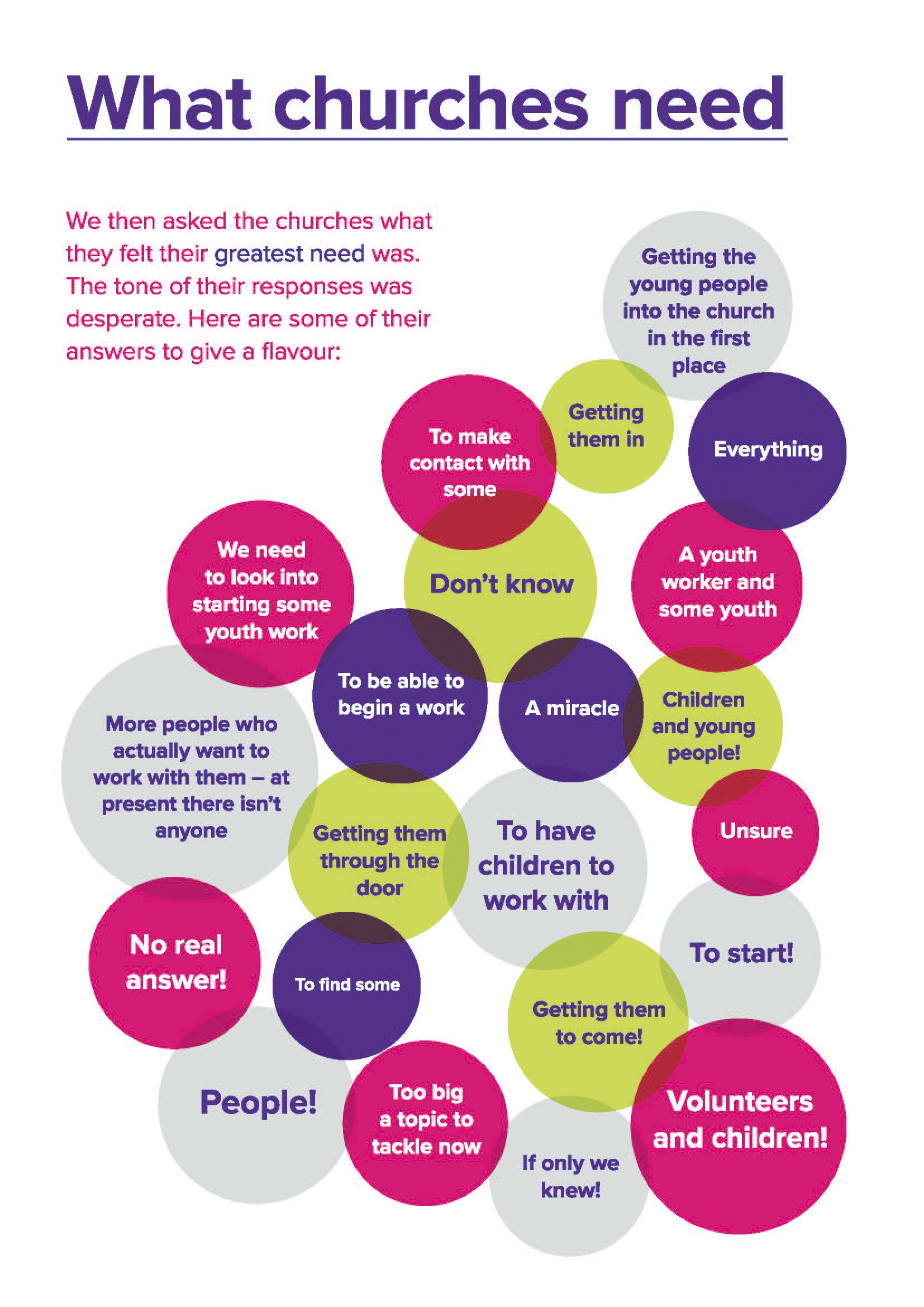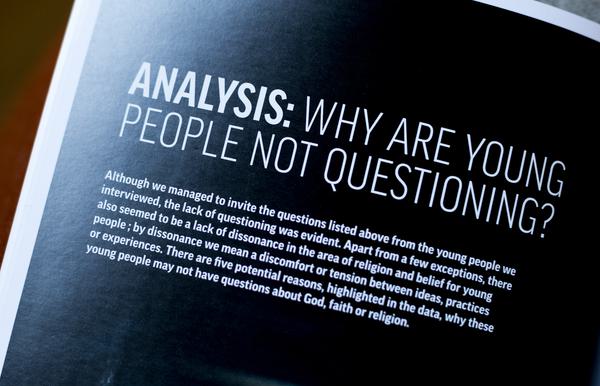Our survey of 2054 churches revealed a lack of confidence and resources when it comes to providing youth work compared to children’s work.
In the Autumn of 2015, we commissioned Christian Research to survey 2054 churches across England, Scotland and Wales (a similar study was already underway in Northern Ireland). Anglican, Baptist and Independent churches are over-represented compared to Catholic, Pentecostal, Presbyterian and Orthodox, which means the results can’t be generalised to all churches. However, as the largest survey of its kind Losing Heart helps us see the broad outline of youth and children’s work across much of the UK and get a sense of what support churches need in this vital ministry.
KEY FINDING 1:
Churches, especially smaller ones, do more children’s work than youth work, and are less confident when it comes to youth work.
Levels of youth and children’s work activity varied according to church size. Nearly all churches offered some form of children’s work on a Sunday – between 80% of small churches (up to 50 congregants) and 99% of large churches (150+ congregants). The same was not true for youth work: 89% of the large churches offered youth work on a Sunday, while only 50% of the small churches did.
Beyond Sundays, 92% of large churches offered a youth group that mainly covered Christian content (92%) while this figure was only 44% for small churches. We also found that respondents from the larger churches were more confident in the effectiveness of their work with children and young people: 92% rated their children’s work effective and 77% rated their youth work effective, while these figures were 54% and 29% respectively amongst those in small churches.
"Our church has never had lots of families and young people in it, and although we have a desire to see them in church we have no clear vision as to how that might be achieved."
Smaller churches have fewer resources and volunteers and are therefore less able to engage in the breadth of activities that larger churches are, and the survey confirmed that the larger the church, the more likely it was that any particular activity would be offered to children and young people, whether groups, camps, baptismal classes or schools work. We might expect small churches to feel less confident than larger churches and yet those in small churches were still generally more confident in their children’s work than their youth work. Indeed children’s work remains more consistent across small, medium and large churches than youth work, especially when it comes to approaches like Messy Church.
How can smaller churches be encouraged and empowered to engage in youth work, both on Sundays and beyond? What can we learn from Messy Church when it comes to supporting small churches?

KEY FINDING 2:
Churches are failing to talk about the topics young people want to discuss
A majority of the churches ‘never’ discussed same-sex attraction (62%), other world faiths (55%) and drugs and addiction (52%) with their young people, despite these being among the most popular topics for the 100 young people we polled. 80% of these young people said they would be ‘very interested’ (47%) or ‘interested’ (33%) in discussing mental health and self-esteem, but 42% of churches never discussed this with their young people. We were also alarmed to discover that only 57% of churches with young people in them ‘often’ discussed the basic beliefs of the Christian faith with them, while 29% reported that they ‘occasionally’ do.
The most under-discussed topic across all churches was pornography, with 68% of respondents saying they ‘never’ talked about this with young people. On this there is some congruence between respondents and young people: of the 18 topics presented, pornography was the subject young people least wanted to discuss in their youth group. But despite being the least popular topic 76% of the young people we asked still said they would either be interested in, or didn’t mind, talking about it – an encouraging number in light of the significance of the issue.
Are young people in your church asked what they want to discuss? What are the best ways for having conversations about potentially difficult subjects?
KEY FINDING 3:
Churches know that they are struggling with their youth and children’s work but don’t know how to fix it
Many churches reported that they lack the people, the funds and the time to keep their youth and children’s work going, and many don’t have any youth work, or any young people to start with. There is a desire to offer something to children and young people, but many churches don’t have the energy or the ideas to make it happen.
As discussed above, survey respondents were more confident in the effectiveness of their children’s work than their youth work. They were invited to share what they felt was and wasn’t going well with their youth and children’s work and common answers to what was going well included: ‘pre-school’, ‘primary age’, ‘messy church’ and other activities that focused on younger children.
However, many respondents struggled to find anything positive to say at all with answers like ‘Nothing sadly, we are an ageing congregation’ or ‘Not much’. When asked about the church’s greatest need was in relation to this work, the tone of many responses was one of desperation.
"We are all over seventy and find it hard. We need younger volunteers."
- ‘Getting the young people into the church in the first place’
- ‘Everything’
- ‘A youth worker and some youth’
- ‘Too big a topic to tackle now’
- ‘If only we knew!’
It is hard to know what comes first, young people leaving the church or a lack of youth provision - but Losing Heart confirms that there is a task facing us when it comes to retaining young people in church as they transition into adolescence. Churches in our survey reported having a higher number of children than young people: 24% of churches had 21 or more children, while only 13% had 21 or more young people. Similarly, 7% had no children, while 14% had no young people.
The greatest need reported by survey respondents was for more committed helpers or leaders, with ageing congregations particularly needing younger leaders. There was an expressed need amongst respondents for youth leaders who are trained and experienced, reflecting a positive desire to find people who are skilled and equipped to work with young people.
"26% of churches we surveyed had young people but no paid or volunteer youth leaders."
Only one third (33%) of the churches surveyed had a paid children’s, youth or family worker, and some churches had no volunteers either. Once again, the figures were worse for youth work, than for children’s work with 7% (177) of the churches reporting having children in the congregation but no volunteers to work with them, while 26% (526) of the churches reported having young people but no volunteers. Finally many respondents recognised the need for children and young people to be supported by the whole congregation, and involved in the whole life of the church.

GAINING CONFIDENCE
We believe there are ways forward for every church when it comes to youth and children’s work, and that we all have something to offer the children and young people in our area. Even if you can’t run a traditional youth group each week, you may be able to develop a mentoring scheme in your church, an old and young people’s club, or an inter-denominational youth project in your area. Take a look at the four case studies in Losing Heart, which we hope will help inspire you to reimagine what is possible.
“This report is more a sober warning from a doctor than an autopsy of a dead body. Youth and children’s work in churches isn’t dead, but we’re badly out of shape and a change of lifestyle is urgently required.”







